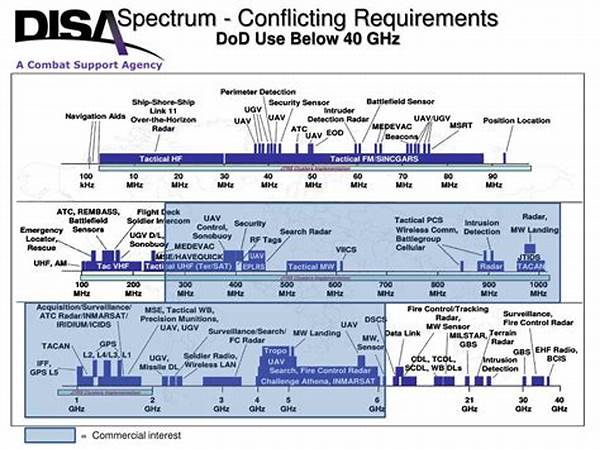In today’s digital age, the ability to manage and control the electromagnetic spectrum is more critical than ever, particularly for military organizations. The military spectrum management strategy is a blueprint for optimizing how military forces utilize these invisible frequencies for communication, navigation, and intelligence gathering. Understanding and implementing these strategies can make or break a military operation, often deciding the thin line between success and failure.
Read Now : Missile Systems On Leander Vessels
The Basics of Military Spectrum Management
At its core, the military spectrum management strategy involves a careful balance of utilizing and protecting radio frequencies. The task is a high-stakes juggling act; imagine trying to keep multiple balls in the air while dodging incoming attacks. Spectrum management in the military is not just about keeping things running smoothly; it’s about staying a step ahead of the adversaries. If enemy forces disrupt or intercept military communications, it can spell disaster. That’s why mastering this digital battleground is crucial for any modern military force. The strategy involves meticulous planning, coordination, and execution, ensuring that military units have constant, secure access to their communications channels without interference.
Core Concepts of Spectrum Management
1. Frequency Allocation: It’s like giving everyone their own lane on a highway. The military spectrum management strategy ensures that each user gets a unique frequency to avoid collisions.
2. Electromagnetic Interference Mitigation: Think of it as noise-canceling headphones for the military. The goal is to reduce unwanted interference that can mess up communications.
3. Spectrum Monitoring: Keeping an eye on those airwaves ensures nothing fishy is happening. Imagine having a 24/7 surveillance system.
4. Dynamic Spectrum Access: Flexibility is king; this approach allows dynamic adjustments so that the military can adapt to unexpected changes in the spectrum environment.
5. Spectrum Sharing: Sometimes you’ve got to share the space. The military spectrum management strategy includes principles for securely sharing frequencies without compromising security.
Challenges and Solutions in Spectrum Management
In terms of challenges, the military spectrum management strategy is like a constantly shifting puzzle with pieces that refuse to stay in place. The frequencies that are the lifeblood of modern operations are crowded and contested. Picture the chaos of a rock concert where everyone wants to be in the front row; it’s a scramble for space. The military’s approach to overcoming these challenges is innovative. Using advanced technology, such as cognitive radios and machine learning algorithms, the strategy pivots towards more intelligent and adaptive solutions. These tools enable dynamic thinking and allow real-time adjustments to ensure uninterrupted communications—a feat essential for operational success.
Read Now : Autonomous Naval Gun Systems
Key Elements of Spectrum Management Strategy
The military spectrum management strategy is an intricate tapestry composed of several essential elements. Firstly, the sheer volume of users can create a congested communications environment. The strategy implements frequency allocation plans designed to minimize signal interference and optimize bandwidth utilization. Secondly, transmission security is paramount. Encrypted communication protocols are employed, rendering intercepted data useless to any adversaries. Thirdly, interoperability is crucial during joint operations involving multiple nations. Standards are developed for spectrum usage to ensure all systems are harmoniously integrated, allowing seamless coordination across allied forces.
Evolving Strategies in Spectrum Management
The modern military spectrum management strategy is not static. It evolves with technology and emerging threats, ensuring the military remains one step ahead. For instance, as cyber warfare becomes a tangible threat, the strategy incorporates elements to protect against spectrum-based cyber attacks. Additionally, the integration of Artificial Intelligence (AI) and machine learning offers proactive spectrum management solutions, allowing the handling of vast amounts of frequency data. This innovation paves the way for real-time decision-making and more efficient bandwidth use, similar to navigating a self-driving car through a busy city.
The Impact of Strategic Spectrum Management
An effective military spectrum management strategy isn’t just about maintaining status quo operations. Its impact extends to fostering innovation. By ensuring reliable communication channels, it provides a bedrock on which emerging technologies, such as unmanned vehicles and field drones, can be developed and deployed. Moreover, it plays a vital role in counterterrorism and defense strategies. Detecting unauthorized spectrum use by adversaries can thwart plans before they materialize into threats. This strategic foresight empowers military forces to stay agile and reactive in the rapidly changing landscape of global security.
The Future of Military Spectrum Management
Looking forward, the military spectrum management strategy anticipates the integration of quantum technologies. Quantum communication promises unparalleled levels of security by using quantum cryptography for secure frequency transmissions. This development is set to revolutionize how spectrum is managed, making unauthorized access nearly impossible. Furthermore, the exploration of frequency bands beyond current radio spectrums, such as terahertz, offers new frontiers for secure communications. The future strategy will continue to tighten its grip on the invisible battlefield, ensuring that military forces have the upper hand.
In summary, the military spectrum management strategy is a sophisticated, ever-evolving framework that adapts to the dynamic landscape of modern warfare. It ensures military forces maintain operational superiority through innovative solutions, strategic foresight, and adaptability to emerging threats. The strategy is not just about management but about anticipating future needs and addressing them proactively. Emphasizing the balance between technological advancement and security, the military spectrum management strategy is fundamental to the success of military operations now and into the future.




